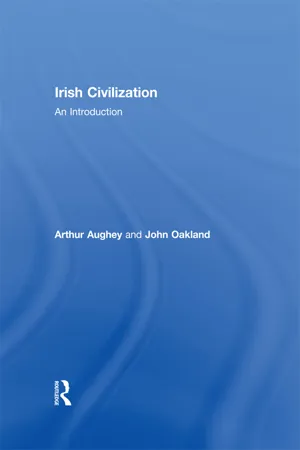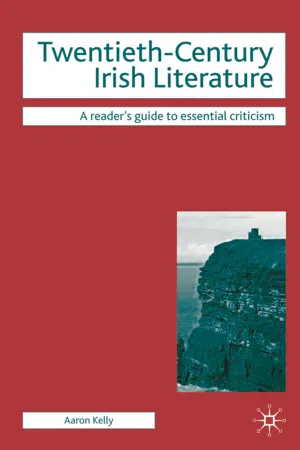Literature
Irish Literature
Irish literature encompasses the written and oral traditions of Ireland, including works in both English and Irish Gaelic. It reflects the rich cultural and historical heritage of Ireland, often exploring themes such as identity, politics, and the natural landscape. From ancient sagas and folklore to modern novels and poetry, Irish literature has made significant contributions to world literature.
Written by Perlego with AI-assistance
Related key terms
Related key terms
1 of 4
Related key terms
1 of 3
3 Key excerpts on "Irish Literature"
- eBook - ePub
Irish Civilization
An Introduction
- Arthur Aughey, John Oakland(Authors)
- 2013(Publication Date)
- Routledge(Publisher)
The 2001 Census reported that 167,487 people (10.4 per cent of the Northern Ireland population) had ‘some knowledge of Irish’ with the highest concentrations of Irish speakers being in Belfast, Londonderry/Derry, Newry/South Armagh, Central Tyrone (between Dungannon and Omagh) and southern Co. Londonderry (near Maghera): 154,622 were Catholics and 10, 987 were Protestants and ‘other Christians’. Most Irish speakers in Northern Ireland speak the Donegal dialect of Ulster Irish. Irish received official recognition in Northern Ireland for the first time in 1998 under the Good Friday (Belfast) Agreement and policy for Irish-medium education is overseen by the Department of Education.Literature
Ireland has contributed much to literature in English and has particularly influenced English literature. Literature in Irish is the third oldest in Europe (after Greek and Latin) and has substantial written and oral traditions. Both languages are central to Irish cultural history.Although literacy was probably not widespread in the general population, the arrival of a Latin-based Christianity from the third to the fifth centuries led to a more literate society. The earliest written literature in Old Irish was in manuscript form; dates from the sixth and seventh centuries; and was poetry or prose based on ancient tales and myths. The major early work consisted of four prose sagas or cycles. The Ulster Cycle contains stories about the Ulaid people (and their leader Cú Chulainn) of Ulster and their conflicts with Connaught. The Fenian Cycle covered the regions of Munster and Leinster, and recounts the adventures of Fionn ma Cumhaill (Finn MacCool) and his warriors, the Fianna.However, Classical Irish poetry became the main literary vehicle in the medieval period rather than prose. Literary form and style were taught in the bardic schools, which produced historians, lawyers and poets who depended on aristocratic patronage. Twelfth-century Anglo-Norman invasions introduced new stories and translations were made from English into Irish. Printing was introduced in Dublin in 1551, but works in Irish were still written in manuscript form. - Frieda Mishan, Frieda Mishan(Authors)
- 2004(Publication Date)
- Intellect Books(Publisher)
The Field (1965) describing, respectively, urban and rural Ireland of the mid-1900s, are good examples of this. Because - in the words of JP Hartely - ‘the past is a foreign country, they do things differently there’ (1953: 1), the literature of earlier generations can be more impenetrable (even to a NS audience) than contemporary literature. This is not to deny the value of looking to the past for the foundations of the culture of the present, for the rationale for contemporary preoccupations, attitudes, values and so on. It is only by reading Irish Literature of the early 1900s, for example, so deeply permeated with the theme of religion (see, for instance, the early works of James Joyce), that the novelty of the religious-secular threshold at which present-day Irish society stands can begin to be understood. The same might be said of English literature, where the evolution of Britain into the multicultural society it has become today may be traced through the works of E. M. Forster, Graham Greene and thence to contemporary literature represented by writers such as Julian Barnes, Ian McEwan and Martin Amis.The issue of multi-culturalism is impossible to avoid in the context of the English language, as has been noted in Chapter 3 Section 3.1.2. The books mentioned above, drawn from the British and Irish cultures relevant to my personal and teaching context, are only two of the many cultures represented through the medium of the English language. The multi-cultural status of English means that the choice of ‘which’ literature to use with learners has socio-cultural, attitudinal or even political implications. It is significant that much English literature with which foreigners still tend to come in contact, embodies value systems that are largely reflective of British, American or European society, rather than those of other English-speaking societies, notably the former British colonies. Indeed, in former times, this factor was often deliberately exploited for politico-cultural ends. The teaching of English in India during the period of the British Raj , for instance, was aimed at the creation of a literate population who would establish the language as that of the elite, and thus ensure cultural dominance of the colonial power (Pugh 1996: 174). The language and culture were deliberately taught as a means of creating ‘a class of persons Indian in blood and colour but English in taste, in opinions, in morals and in intellect’ (from Lord Macaulay’s dictum of 1834 quoted in Phillipson 1992: 110). Linguistic imperialism was even justified, in the minds of some, on grounds of Godliness. Winchester (1998) parodies the views of the ruling classes in the late 19th century: ‘God - who in this part of London society was held to be an Englishman - naturally approved of the spread of the language as an essential imperial device’ (Winchester 1998: 68-9). The relationship portrayed between Robinson Crusoe and Man Friday in Defoe’s 1719 classic has likewise been branded an example of linguistic imperialism, as well as ‘reflecting the racial structure of western society at the heyday of slavery’ (Phillipson 1992: 109). What is significant is that first of all, it is Man Friday who must learn Crusoe’s language; secondly, the reason for this is so that he can serve him; and thirdly, in Defoe’s fantasy, Man Friday is only too eager to assume this role: ‘I was greatly delighted with my new companion, and made it my business to teach him everything that was proper to make him useful, handy and helpful; but especially to make him speak, and to understand me when I spake, and he was the aptest schollar that ever was’ (Defoe 1719; 1965: 213). The imperialist stance of the book did not go unrecognised and, indeed, it was actually deployed in the latter days of the British Empire to imperialist ends. Robinson Crusoe- eBook - ePub
- Aaron Kelly(Author)
- 2008(Publication Date)
- Bloomsbury Academic(Publisher)
Using both Greek and English literature as his template, Yeats identified three key formal movements in the development of a nation’s literature: narrative or epic poetry, a dramatic period and finally lyric poetry. Ireland, since its full national character remained unexpressed, was for Yeats in the first, formative, epic or ballad period of building national self-consciousness. To Yeats, the best Irish writers – Ferguson, Mangan, Davis and O’Grady – are epic or ballad writers whose work has the value of giving heroic form to a renewed and unitary Irish identity: ‘Our poetry is still a poetry of the people in the main, for it still deals with the tales and thoughts of the people’. 14 A comparable national unity and consciousness whereby artists and intellectuals may shape, elevate and synthesize the untainted pre-modern simplicities of the Irish peasant is to be found in Yeats’s ‘The Literary Movement in Ireland’ (1901). 15 The task of art in an era of material debasement, according to Yeats, is to provide ‘a voice of the idealism of the common people’. 16 However, Yeats’s ideal of an art reconciled with its people and a people reconciled with its art has been highly problematic for his critics and detractors. His assertion that the foundation of Irish Literature is ‘fixed in legend rather than in history’ has, for his opponents, less to do with the national revival of an immemorial Irishness deprived of its immediate continuity by British impingement and more to do with constructing a consolatory myth for the Anglo-Irish Ascendancy in the face of the reality of their imminent demise. 17 It is notable that Yeats desires, to appropriate one of his own terms, a unity of culture between artist and common people, but that unity is a highly selective one. The social basis of the Ireland which Yeats wished to reawaken has a clear three-tier structure: Three types of men have made all beautiful things
Index pages curate the most relevant extracts from our library of academic textbooks. They’ve been created using an in-house natural language model (NLM), each adding context and meaning to key research topics.
Explore more topic indexes
Explore more topic indexes
1 of 6
Explore more topic indexes
1 of 4


